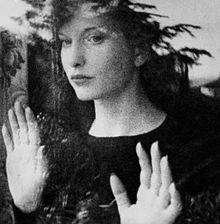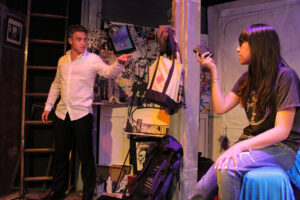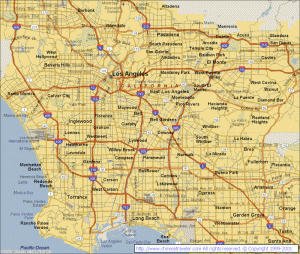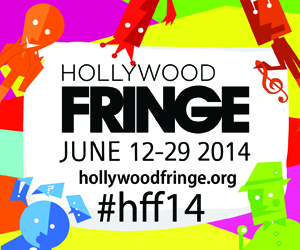Polish Art Warriors Ride in on a Rare SoCal Storm
One Night in Santa Ana
Art warriors come in all shapes and sizes. One of my favorites was in the area last month: Joanna Klass, direct from Warsaw, Poland, where she runs WarsawBauhaus with her partner, the artist Wojtek Szaszor. Invited to attend an open mic happening-exchange and roundtable discussion Joanna and Wojtek were holding at a vacant space in the Santora Arts Building in Santa Ana, I drove south through the rain on a Saturday night last month into the heart of Orange County. By 8 p.m., a group of us had straggled out of the weather into the bare exhibition space on Broadway, which was selected for the event by the artist Allen Moon of Santa Ana Sites. Entering the gallery, we were greeted by footage and Taiji Ito’s arresting score from Meshes of the Afternoon (1943), by the Russian-born experimental film-maker and choreographer Maya Deren (created in 1943 in collaboration with her husband Alexander Hammid), which was projected huge on the wall, and by an enamel pot of steaming borscht – enough for a company of Cossacks – set out nearby on a folding chair.
Meshes of the Afternoon (1943), score by Taiji Ito
https://www.youtube.com/watch?v=zpBUhbecZDY
As soon as a quorum assembled, Joanna and Wojtek had us move our chairs into an oval in the front portion of the gallery space, joining a diverse group of artists, arts administrators and academics rolling in from the North (Pasadena, Hollywood, and West LA) and from the South (Soka University of Aliso Viejo) — along with celebrity outsiders such as Reno, the comedienne from New York City.
We began to talk about what is important when it comes to art-making in Southern California — in a pragmatic-materialistic culture like America’s that was founded on the idea that we can find answers to all life’s questions, artists are drawn to questions that have no easy answers. Artists, as often as not, appear as the worm in the apple, the fly in the ointment – at best a regrettable necessity whom it makes no sense to celebrate, much less waste public money on.
Among other topics and conversational vectors, the exchange heated up around how the complaints and problems of artists measure up against the material needs of hungry people. Is art relevant to vulnerable populations, or does the need for expression and connection exist alongside the need for bread and water? Are these varied needs simultaneous and complementary, or hierarchical?
The painter Arie Galles and his wife Sara Nuss-Galles grew up in war-torn Europe, and found purpose in creating art when they were refugees in Russia; Sally Fairman works with inner city kids, helping them to use artistic expression to stay out of prison and the soul-killing disaster of the American “justice” system. Debate on this point flowed back and forth before some consensus began to emerge: expressivity remains a vital force, as crucial to the poor as to the well-heeled.
Poet, writer and music historian Maja Trochimczyk read a beautiful poem from a recent volume of her work. Comedian Reno, or “Citizen Reno,” as Joanna describes her, arrived with some welcome voltage, bringing the conversation back again to the issue of topicality, and how potent forms of artistic expression can sometimes be found in what seems to be pure entertainment. Wojtek Szaszor, meanwhile, drifted around the periphery of the room, performing minor acts of Dadaist sorcery involving an immense, inflated blowfish together with an array of ripe oranges.
The larger questions are not whether the arts are relevant, or to whom they matter. There’s no evidence that the numbers of people creating art is in any way diminishing. But when people of all colors and stripes create it, as they’re obviously inclined to, how many people care enough about viewing it? That’s the diminishment on these shores that’s been reported by the National Endowment of the Arts. Has narcissism taken us to a land beyond where we partake of art made by other people?
In a different era, we would have been drinking and smoking, but on this evening we weren’t drinking – we had to drive – and nobody smokes anymore. Nevertheless, as we began to go our separate ways back into the rain, a poem by Czeslaw Milosz, “An Appeal,” kept running through my mind, and I quote a few lines here, out of Robert Haas’ translation:
From a landscape of cranes and canals,
Of tangled railway tracks and winter fog,
In the smoke of black tobacco, I make my way
Toward you and I ask you a question.
Tell me, for once at least laying
Caution aside, and fear and guarded speech,
Tell me, as you would in the middle of the night
When we face only night, the ticking of a watch,
The whistle of an express train, tell me
Whether you really think that this world
Is your home? That your internal planet
That revolves, red-hot, propelled by the current
Of your warm blood, is really in harmony
With what surrounds you? Probably you know very well
The bitter protest, every day, every hour,
The scream that wells up, stifled by a smile,
The feeling of a prisoner who touches a wall
And knows that beyond it valleys spread,
Oaks stand in summer splendor, a jay flies
And a kingfisher changes a river to a marvel.
God bless the Poles, and let more of their magic descend upon Southern California – we need it as badly as we need the rain.
Guy Zimmerman is a playwright and director



